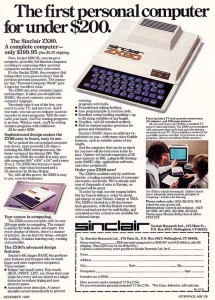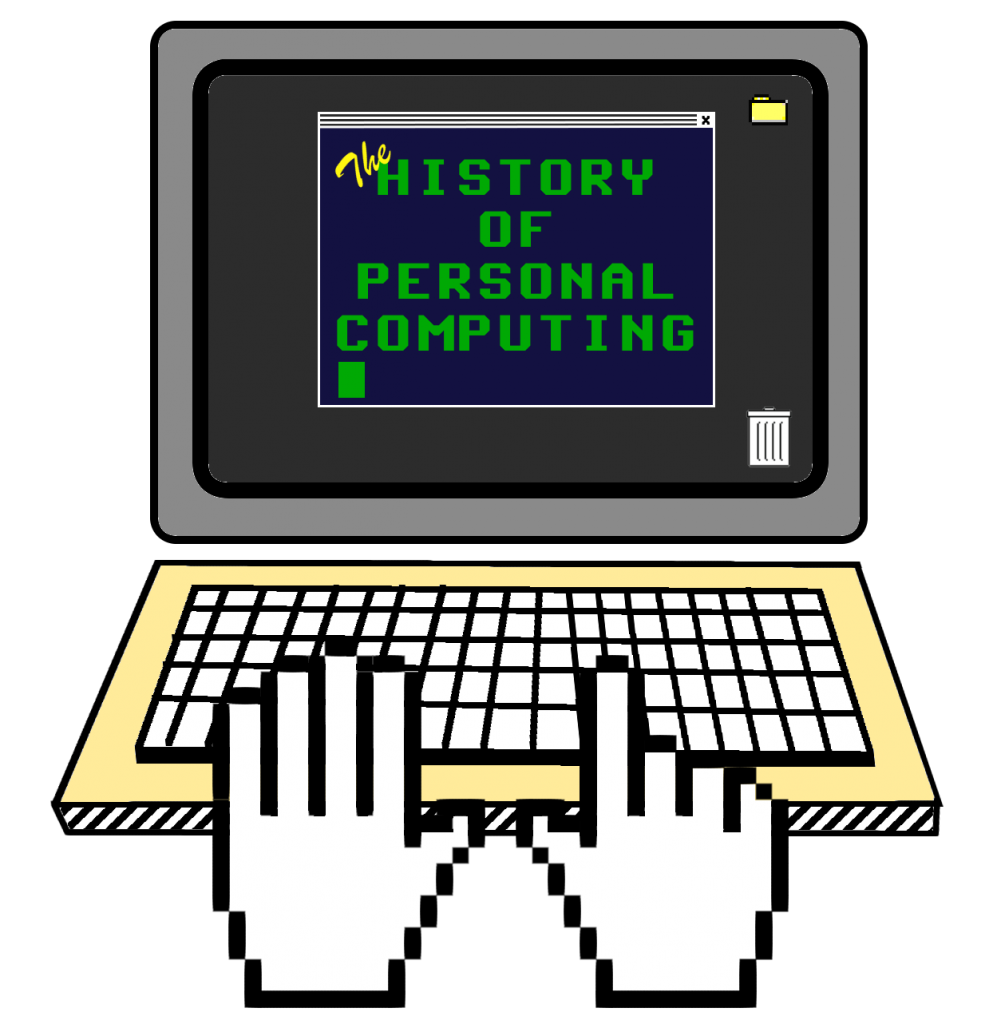Sinclair ZX80
What happens when you strip most of the metal from those earlier homebrew computers, toss in a third-party Z-80 clone CPU, and have what’s left expertly bound together by a disciple of a miniaturization luminary? You get the compact ZX80 personal computer!
The Sinclair ZX80 was released in 1980 and was arguably the first British personal computer, though the company had previously released the MK14 in 1977, and Acorn had released a similar product, the System 1 in 1979. However, both of those were simply single-board computers and the ZX80 was complete in a case. It was named after its CPU, along with an “X” for “the mystery ingredient.” Clive Sinclair (now Sir Clive) willed it into existence at Science of Cambridge, his company later be known as Sinclair research. It was targeted to individual, ordinary users, and it was the first British micro to go on sale for under £100. It was available in kit form for £79.95, and as a ready-built version for £99.95. Some 50,000 would be sold before the ZX80 was discontinued in 1981. This was significant, and the UK lead the world in personal computer ownership throughout the 1980s. It was succeeded by the barely different ZX81 in 1981, which was also sold in the US as the Timex Sinclair 1000. The ZX series of computers went on to sell over 1.5 million units by 1984, before being discontinued. A large cottage industry of programs, magazines and products arose around it. This commercial success made Sinclair Research one of Britain’s leading computer manufacturers and earned a fortune and the eventual knighthood for the company’s founder.
| Listen to our podcast episode about the Sinclair ZX80 (and Sharp MZ-80K) computer here |
- System specs
- 3.2MHz NEC D780C-1 Z80 compatible CPU
- 1K Static RAM
- 4K ROM. System functions and BASIC fit in the 4K ROM space
- 32 x 24 text display
- Membrane Keyboard
- $199 US starting price (widely advertised as the first personal computer for under $200)
- Peripherals
- 8K BASIC Module
- 16K RAM Module
The Company
In July 1961, Clive Sinclair founded his first company, Sinclair Radionics Ltd. in Cambridge. Sinclair Radionics developed hi-fi products, radios, calculators and scientific instruments. The company struggled during the mid to late 1970s and ultimately failed, even with government investment. In the mid-70s, when it was clear that Radionics was failing, Clive Sinclair prepared so that he could continue to pursue his own commercial goals. He had purchased another small company for just such an eventuality, which ultimately came to be known as Sinclair Instrument Ltd. in August 1975. Sinclair encouraged Chris Curry, who had been working for Radionics since 1966, to leave that company and get his new Sinclair Instrument setup and operating. They developed the “Wrist Calculator” to generate cash, which soon became a commercial success. In July 1977 Sinclair Instrument Ltd was renamed to Science of Cambridge Ltd., and around the same time Ian Williamson showed Chris Curry a prototype microcomputer based on a National Semiconductor SC/MP microprocessor and parts taken from a Sinclair calculator. This was sold as the MK14 microcomputer kit. Science of Cambridge ultimately became Sinclair Research Ltd. in 1981.
The company or companies make for an interesting and complex story. There’s a great BBC movie about what happened here, and what happened after, with Clive Sinclair’s rivalry against Chris Curry’s Acorn computers (makers of the BBC Micro). This excellent movie can now be viewed on YouTube by people from different nations!
The Legacy
In 1982 the Sinclair ZX Spectrum was released, later becoming Britain’s best selling computer, competing aggressively against Commodore and Amstrad. Unfortunately, Sinclair had a misstep with its Sinclair QL (for Quantum Leap) personal computer launched in 1984. Although the computer was hyped as being advanced for its time, and relatively cheap, it failed to sell, and production was suspended in 1985. Amstrad acquired Sinclair’s computer products lines in April 1986.
Emulation
- Javascript ZX80 Emulator – http://nocanvas.zame-dev.org/0004/
- Runs right in the browser
- Works with the PC keyboard, but MUST follow the onscreen ZX80 keyboard template. Characters are not remapped.
- Provides a link to an online version of the ZX80 BASIC manual. You can relive those days when you had this computer hooked up and you are learning BASIC from the included manual.
- Press the on screen “Load Game” button and it will load a simple block graphic space invaders game.
- EightyOne – http://www.chuntey.com/
- Runs in Windows
- Mimics an “authentic” TV screen with raster interference. Those effects are highly configurable.
- Will emulate the ZX80, ZX81, various ZX Spectrum models, Amstrad Spectrum clones, Timex TS1000/TS1500/TC2048, Jupiter Ace, and even a couple homebrew clone configurations.
- Supports ZX80/81 tape files
- Comes with a handful of software in tape format.
- Pop-up keyboard templates for the selected model
- Will load raw WAV files containing program data.
- Emulates the ZX Printer with variable “print speed”
- It even mimics the infamous “RAM Pack Wobble!”


